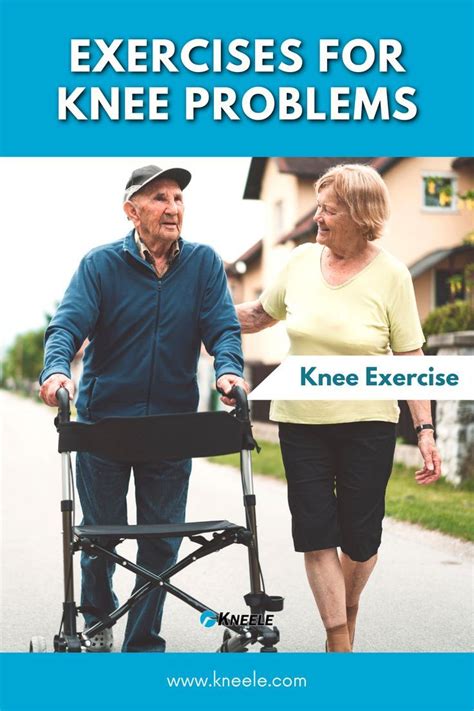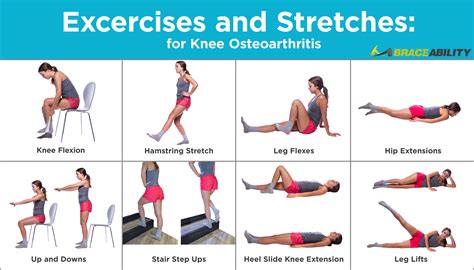Intro
Strengthen your knees with effective knee pt exercises, including physical therapy and rehabilitation techniques, to improve knee stability, relieve pain, and enhance overall knee health and function.
Knee pain is a common issue that affects millions of people worldwide, causing discomfort, limiting mobility, and affecting overall quality of life. One of the most effective ways to alleviate knee pain and strengthen the surrounding muscles is through exercises specifically designed for the knee joint. Knee exercises, also known as knee PT exercises, are a series of movements and stretches that target the muscles around the knee, including the quadriceps, hamstrings, and ligaments. These exercises can help improve knee function, reduce pain, and enhance overall mobility.
Regular knee exercises can be beneficial for individuals who suffer from knee pain, whether it's due to injury, arthritis, or other conditions. By strengthening the muscles around the knee, individuals can improve their knee stability, reduce the risk of further injury, and enhance their overall athletic performance. Moreover, knee exercises can be modified to suit different fitness levels, making them accessible to people of all ages and abilities. Whether you're a professional athlete or simply looking to improve your overall health, incorporating knee exercises into your routine can have a significant impact on your knee health and overall well-being.
Knee exercises can be performed in various settings, including at home, in a gym, or with the guidance of a physical therapist. They can be tailored to address specific knee conditions, such as patellofemoral pain syndrome, ligament sprains, or meniscal tears. By incorporating a combination of strengthening, stretching, and mobility exercises, individuals can experience significant improvements in their knee function and reduce their risk of future injuries. With the right exercises and a consistent routine, individuals can take the first step towards achieving healthy, pain-free knees.
Knee Anatomy and Function

The knee joint is also supported by several ligaments, including the anterior cruciate ligament (ACL), posterior cruciate ligament (PCL), medial collateral ligament (MCL), and lateral collateral ligament (LCL). These ligaments provide stability and support to the knee joint, allowing for smooth movement and rotation. The menisci, two cartilage structures located between the femur and tibia, act as shock absorbers and help reduce friction between the bones. Understanding the intricate anatomy and function of the knee joint is crucial for developing targeted exercises that address specific knee conditions and improve overall knee health.
Benefits of Knee Exercises

Knee exercises can also improve athletic performance by enhancing power, speed, and agility. Strengthening the quadriceps and hamstrings can help improve knee extension and flexion, allowing for more efficient and effective movement. Additionally, knee exercises can help reduce the risk of knee injuries, such as ligament sprains or meniscal tears, by improving knee stability and reducing the stress on the knee joint. By incorporating knee exercises into their routine, individuals can experience significant improvements in their knee health and overall athletic performance.
Types of Knee Exercises
Knee exercises can be classified into several types, including strengthening, stretching, and mobility exercises. Strengthening exercises, such as squats and lunges, target the quadriceps and hamstrings, helping to improve knee stability and reduce pain. Stretching exercises, such as hamstring and quadriceps stretches, help improve flexibility and reduce muscle tension. Mobility exercises, such as knee extensions and flexions, help improve knee movement and reduce stiffness.Other types of knee exercises include balance and proprioception exercises, which help improve knee stability and reduce the risk of falls or further injury. These exercises can include single-leg squats, balance boards, or BOSU ball training. Functional exercises, such as stair climbing or step-ups, can help improve knee function and mobility in everyday activities. By incorporating a combination of these exercises into their routine, individuals can experience significant improvements in their knee health and overall athletic performance.
Knee Exercise Routine

- Warm-up: 5-10 minutes of light cardio, such as jogging or cycling, to prepare the knee joint for exercise
- Strengthening exercises: 3 sets of 10-15 repetitions of squats, lunges, and leg press to target the quadriceps and hamstrings
- Stretching exercises: 3 sets of 30-second holds of hamstring and quadriceps stretches to improve flexibility and reduce muscle tension
- Mobility exercises: 3 sets of 10-15 repetitions of knee extensions and flexions to improve knee movement and reduce stiffness
- Balance and proprioception exercises: 3 sets of 10-15 repetitions of single-leg squats, balance boards, or BOSU ball training to improve knee stability and reduce the risk of falls or further injury
It's essential to start slowly and gradually progress the exercise routine as the knee joint becomes stronger and more mobile. Individuals should also listen to their body and stop exercising if they experience any pain or discomfort. By incorporating a well-structured knee exercise routine into their daily routine, individuals can experience significant improvements in their knee health and overall athletic performance.
Common Knee Exercises
Some common knee exercises include: * Squats: a strengthening exercise that targets the quadriceps and hamstrings * Lunges: a strengthening exercise that targets the quadriceps and hamstrings * Leg press: a strengthening exercise that targets the quadriceps and hamstrings * Hamstring stretch: a stretching exercise that targets the hamstrings * Quadriceps stretch: a stretching exercise that targets the quadriceps * Knee extensions: a mobility exercise that targets the quadriceps * Knee flexions: a mobility exercise that targets the hamstrings * Single-leg squats: a balance and proprioception exercise that targets the quadriceps and hamstringsThese exercises can be modified to suit different fitness levels and knee conditions. For example, individuals with knee pain or instability may start with gentle exercises, such as knee extensions and flexions, and gradually progress to more challenging exercises, such as squats and lunges.
Preventing Knee Injuries

- Warming up properly before exercise or sports
- Using proper techniques and equipment
- Strengthening the muscles around the knee
- Improving flexibility and mobility
- Avoiding overtraining and excessive stress on the knee joint
- Wearing proper footwear and protective gear
By taking these precautions, individuals can reduce their risk of knee injuries and maintain healthy, pain-free knees. It's also essential to listen to the body and stop exercising if any pain or discomfort is experienced. Early detection and treatment of knee injuries can help prevent long-term damage and improve overall knee health.
Knee Injury Treatment
Knee injury treatment depends on the severity and type of injury. Mild knee injuries, such as minor sprains or strains, can be treated with rest, ice, compression, and elevation (RICE). More severe knee injuries, such as ligament sprains or meniscal tears, may require physical therapy, bracing, or surgery.Physical therapy can help improve knee function, reduce pain, and enhance overall mobility. A physical therapist can develop a customized exercise program to address specific knee conditions and improve overall knee health. Bracing can help stabilize the knee joint and reduce stress on the surrounding muscles and ligaments. Surgery may be necessary for severe knee injuries, such as torn ligaments or meniscal tears, to repair or replace damaged tissues.
What are the most common knee exercises?
+The most common knee exercises include squats, lunges, leg press, hamstring stretches, quadriceps stretches, knee extensions, and knee flexions. These exercises can help improve knee function, reduce pain, and enhance overall mobility.
How often should I exercise my knees?
+It's recommended to exercise your knees 2-3 times per week, with at least one day of rest in between. This can help improve knee function, reduce pain, and enhance overall mobility without overtraining or causing excessive stress on the knee joint.
Can knee exercises help prevent knee injuries?
+Yes, knee exercises can help prevent knee injuries by strengthening the muscles around the knee, improving flexibility and mobility, and enhancing overall knee function. By incorporating a well-structured knee exercise routine into your daily routine, you can reduce your risk of knee injuries and maintain healthy, pain-free knees.
In conclusion, knee exercises are a crucial component of maintaining healthy, pain-free knees. By incorporating a combination of strengthening, stretching, and mobility exercises into your daily routine, you can improve knee function, reduce pain, and enhance overall mobility. Remember to start slowly, listen to your body, and seek professional advice if you experience any pain or discomfort. With the right exercises and a consistent routine, you can take the first step towards achieving healthy, pain-free knees. We encourage you to share your experiences with knee exercises, ask questions, and provide feedback in the comments section below.
